
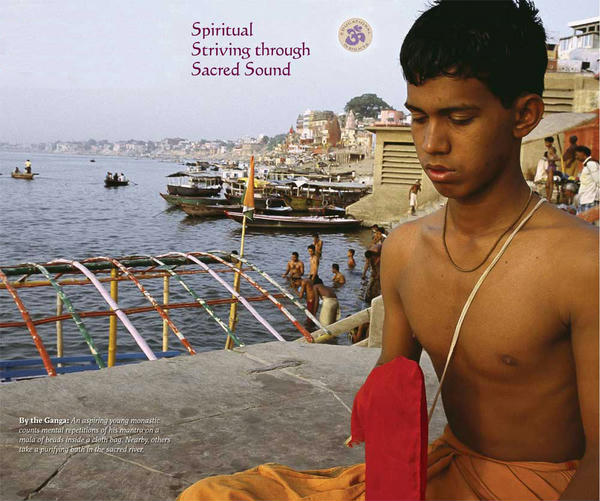
E D U C A T I O N A L I N S I G H T
Mantra Yoga
The recitation of mantras, known as japa, lies at the very heart of Hindu practice. Focusing the mind on Divinity as part of one’s daily sadhana, it unites bhakti with meditation, body with mind, worship with introspection, opening inner doors to realms beyond the senses.
INTRODUCTION BY SATGURU BODHINATHA VEYLANSWAMI
 mantra is a syllable, word or phrase endowed with special power, usually drawn from scripture. Mantras are chanted loudly during puja to invoke the Gods and establish a spiritual force field. Certain mantras are repeated softly or mentally for japa, or mantra yoga, the subtle tones quieting the mind, harmonizing the inner bodies and stimulating latent spiritual qualities. Hinduism’s universal mantra is Aum.
mantra is a syllable, word or phrase endowed with special power, usually drawn from scripture. Mantras are chanted loudly during puja to invoke the Gods and establish a spiritual force field. Certain mantras are repeated softly or mentally for japa, or mantra yoga, the subtle tones quieting the mind, harmonizing the inner bodies and stimulating latent spiritual qualities. Hinduism’s universal mantra is Aum.
Japa refers to the repetition of a mantra, often while counting on a mala or strand of beads. It may be done silently or aloud. Japa is one of the ten niyamas (spiritual practices) of ashtanga yoga, often performed prior to meditation. It is a major sadhana in Hindu spiritual practice, from the simple utterance of one or more names of God to extraordinary feats of repeating sacred syllables millions of times for years on end. Japa is recommended as a cure for pride and arrogance, jealousy, fear and confusion. It harmonizes the doshas and quiets the vrittis. Filling the mind with divine sounds, awakening the divine essence of spiritual energies in the physical body, japa brings forth the amrita. Doshas are the three bodily humors, which, according to ayurveda, regulate the body: vata, pitta and kapha. Vrittis, in yoga psychology, are the fluctuations of consciousness, the waves of mental activities of thought and perception. Amrita is the nectar of divine bliss which flows down from the sahasrara chakra when one enters the deepest states of meditation.
For Saivite Hindus, Namah Sivaya in its various forms is the most treasured mantra used in japa. The mantra Hare Rama Hare Krishna is among the foremost Vaishnavite mantras. Aum is a universal mantra. Sage Patanjali extolls it in his Yoga Sutra: “The mantra AUM should be repeated while contemplating on its meaning. Thence follows the attainment of inward-mindedness and the disappearance of the obstacles. Sickness, apathy, doubt, carelessness, sloth, sensual indulgence, false perspective, lack of progress and lack of consistency are all distractions to the mind and are the obstacles. Pain, depression, trembling limbs and irregular inhalation and exhalation accompany these distractions” (I.23–31).
Patanjali speaks of 14 kinds of japa: daily (nitya), circumstantial (naimittika), the japa of desired results (kamya), forbidden (nishiddha), penitential (prayashchitta), unmoving (achala), moving (chala), voiced (vachika), whispered (upanshu), murmured (bhramara), mental (manasa), uninterrupted (akhanda), nonuttered (ajapa) and circumambulatory (pradakshina).
Here are four suggestions on how to perform japa.
1. Perform japa aloud in the beginning stages, as it is easier to concentrate the thought. Once you can perfect performing japa aloud, move on to performing it silently.
2. Pronounce the mantra slowly, properly, thoughtfully, with feeling.
3. Do not intensify japa by reciting your mantra tens of thousands of times a day unless specifically instructed to do so by your guru. Intensifying japa without a guru’s guidance could produce negative results.
4. The best place and time to perform japa is in the temple or your home shrine after a puja. Thus practiced, japa will calm your mind, balance your inner and outer forces and strengthen your spiritual practice.
The Magic of Japa
From the Teachings of Satguru Sivaya Subramuniyaswami
 APA IS VERY WIDESPREAD IN HINDUISM, MORE SO THAN MEDITATION. japa yoga is easy to practice. The inexperienced can take it up immediately. It does produce certain results until they forget the mantra, which can happen! This may seem strange, but I have met devotees of gurus who had actually forgotten their mantra, even after paying a goodly sum to receive it. The innocent Americans and Europeans are the orphans and adopted children of Indian gurus. Some of these teachers, unaware of the critical differences of religion and culture of their newfound and eager devotees, respond by bringing them immediately into japa and raja yoga, avoiding the known initiations and the basic philosophical and cultural foundations necessary for ultimate success. In the case of Indian devotees, these cultural and philosophical foundations would have been acquired within the family home. This foundation is necessary, as it directs the subconscious mind, which is the inner motor of a person, preventing him from opposing, inhibiting and invalidating the realizations that naturally occur when one practices yoga. So, first we learn the philosophy, then through japa and more advanced yogas we realize it. Whereas in performing japa and raja yoga before you know the philosophy, what you previously learned may conflict with what you now realize. This can be very disconcerting.
APA IS VERY WIDESPREAD IN HINDUISM, MORE SO THAN MEDITATION. japa yoga is easy to practice. The inexperienced can take it up immediately. It does produce certain results until they forget the mantra, which can happen! This may seem strange, but I have met devotees of gurus who had actually forgotten their mantra, even after paying a goodly sum to receive it. The innocent Americans and Europeans are the orphans and adopted children of Indian gurus. Some of these teachers, unaware of the critical differences of religion and culture of their newfound and eager devotees, respond by bringing them immediately into japa and raja yoga, avoiding the known initiations and the basic philosophical and cultural foundations necessary for ultimate success. In the case of Indian devotees, these cultural and philosophical foundations would have been acquired within the family home. This foundation is necessary, as it directs the subconscious mind, which is the inner motor of a person, preventing him from opposing, inhibiting and invalidating the realizations that naturally occur when one practices yoga. So, first we learn the philosophy, then through japa and more advanced yogas we realize it. Whereas in performing japa and raja yoga before you know the philosophy, what you previously learned may conflict with what you now realize. This can be very disconcerting.
When the philosophy is properly understood, we possess right thought, right speech and right action, which is proper behavior. This is culture. Humility and obedience before elders and those who are wiser is a very big part of Hindu culture, as is the regard for knowledge and wisdom and the deeper philosophies. Therefore, a good character expressed day by day within the individual who is freed from anger and from contentious mental arguments is a central foundation for the practice of yoga.
One without such purity should not practice japa yoga, lest he awaken the knowledge of his imperfections which are better to keep veiled. For knowing such could send him into states of remorse, early repentance—which means being penitent before one has the stability to take on the reaction of such a momentous discovery and undertaking. Karma yoga should be practiced by the devotee prior to this to smooth out all character flaws. Sivathondu—which is another word for karma yoga—service to Siva, is the platform for japa yoga.
Those who are victims to episodes of anger, to pangs of jealousy or to periods of fear should not meditate and should not perform japa. They should perform Sivathondu, attend group meditations and group pranayama sessions. This is because they must first be lifted up into the muladhara chakra and above. They are living below it and must raise their consciousness in order to proceed deeply into themselves. It is the group itself in this case that will lift the individual who cannot easily lift himself. This process should be guided by a strong-minded, compassionate moderator.
IN THE VEDAS
Yoga historically likely began with mantra yoga as its original form. The oldest yogic text and spiritual teaching coming out of India, the Rig Veda, is primarily a teaching of mantra yoga. The Rig Veda is composed of sacred chants (like the Gayatri Mantra to the Sun God) designed to invoke the cosmic powers within us for their blessings and guidance. The Vedic ritual is based upon Agni or the sacred fire, which is regarded first of all as a power of divine speech and mantra. This sacred fire, which is inwardly the power of speech, serves to invoke and manifest all the deeper powers of the psyche and the greater cosmos. This Vedic mantra yoga is still accessible to us through learning Vedic chanting. Yet we should learn to use Vedic mantras along with the breath and meditate upon their profound meanings if we want the deeper aspects of the Vedic yoga to become clear to us.
Vamadeva Shastri
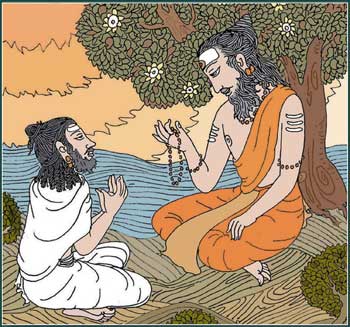

Passing on the power: A devotee receives instruction in mantra recitation from his guru; a priest at the Sri Naranayi Pitham in South India counts the names of Shakti on a strand of small rudraksha beads
Japa Opens Inner Doors
One who performs japa properly will realize what he knows. You see, japa opens up the inner mind and focuses the energies of certain chakras, which are consciousness encased within the psychic nerve ganglia of the nadi network. Therefore, if he is a divine person, he will realize that Divinity. If he is an angry, selfish person, then he will realize that. We would want him to realize the former but not the latter. Through karma yoga, Sivathondu, the angry, hateful, contentious, competitive person will face himself through a series of small situations in which small realizations will occur. The instinctive nature and habits will be corrected until the individual is able to work smoothly over long periods of time. We would not want to open up his mind to the impurities, lest he become depressed or even morose and suicidal. Therefore, japa yoga obviously is an initiation that should come a little down the road, farther down the path.
Generally those who want to practice japa yoga and do have impurities working within them fall away from repetitive mantras very quickly, becoming a little afraid of what might happen if they are successful. Their own soul is watching after them in this early stage. Then there are those who are ardent, fanatical, you might say, who want to get results in a limited period of time and have no sense of the consequences. They work tirelessly to do this. The wise guru would discourage much practice of intense mantras or meditating alone, and would instead encourage karma yoga, giving to others, working for work’s sake, serving for service’s sake, not looking for rewards. Group meditations and group chanting are fine at this stage, as is temple worship, until the purification process has had time to work its magic.
RISHI TIRUMULAR ON JAPA YOGA
By One Letter, A, He all worlds became. By Two Letters (A and U), He the Two became—Siva and Sakti. By Three Letters (A, U and M), He the Light became. By Letter M was Maya ushered in. 885
This is the way to chant: “Sivayanama, Sivayanama.” If you chant that way, no more birth will be. With the Lord’s grace, you shall behold the eternal dance; and copper (that is Jiva) turns into gold (that is Siva). 905
This mantra is golden; chant it not loud, just say it. Your body glows red. If you take it in slowly, as you breathe in, your body becomes gold, and in time, you shall behold the golden feet of the Lord. 906
You shall behold the golden feet; you shall have children noble. In the name of that golden feet I say, the copper that is jiva will become gold that is Siva, and as you behold the golden feet, you too shall His form assume. Center the mantra in your thoughts, and witness the goodly dance of golden feet. 907
Tirumantiram
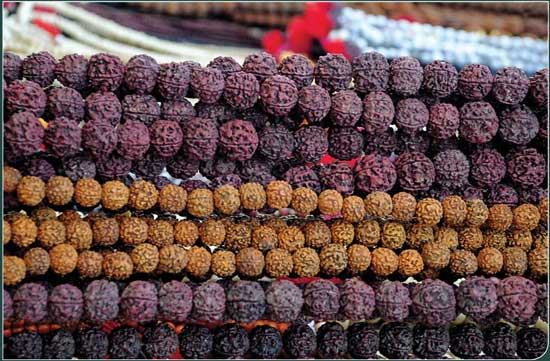
Counting on sacred beads: Strands, called malas, of various rudraksha beads stacked high in an Indian store; A man prepares himself for the performance of japa
. . . . . . . . . . . . . . . . . . . . . . . . . . .
The Power of Initiation
Oftentimes japa and chanting are the ardha-Hindu’s or non-Hindu’s first introduction to Sanatana Dharma. An ardha-Hindu is often one who has been given a Hindu first name. It is our experience over the last fifty years that their japa has little effect unless they make the full commitment to becoming stalwart members of the Hindu religion and join a mature community. Those who are inside a department store handling and purchasing the merchandise and those outside looking through the window at the same merchandise are two different groups. Ardha means half, and ardha-Hindus are those who have come half way to making a full commitment and are still making up their mind. They are still on the outside looking in. Their japa doesn’t have much power until they bring other aspects of their life into line with the Hindu dharma.
For the non-Hindu who has not made a commitment, the universal mantra Aum is the most significant and precious of all mantras. This can be chanted by those of all religions, without restriction. The sounds of a city make “Aum.” A child at birth says “Aum.” A mother giving birth says “Aum.” The last breath of a dying person is “Aum.” Even the cows say “Aum.” Aum is the mantra of Lord Ganesha. All are striving for His holy feet. Those who are struggling with the lower nature and those who have not made a commitment to the Sanatana Dharma (a commitment which for the newcomers to the fold could be verified by their Hindu name on their passport) should all chant Aum.
To demonstrate the authority vested in the mantra, let me tell you a story. A minister in a court was summoned before the maharaja. The minister also happened to be a brahmin priest, a kulaguru with the power to give initiation in the most sacred mantra, Aum Namah Sivaya. The king asked him, “We would like you to initiate me into the sacred Panchakshara Mantra.” The guru said, “Yes, Majesty, I shall begin preparing you for your initiation.” Then the king decreed: “No, we will take the initiation right now, and never mind the preparations.” The kulaguru objected, “This is quite impossible. My guru restricts me from giving initiation without due preparation.” The king retorted, “So, we will do the mantra without you. Or else explain to me how the mantra would work differently with the initiation than without.” The kulaguru said, “Yes, Majesty, I shall give you an explanation.”
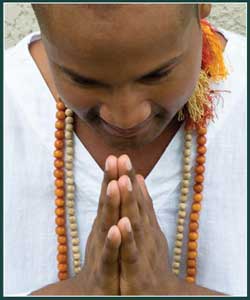
HOW TO CHANT AUM
For Aum japa to be effective, the mantra must be pronounced correctly. The first syllable is A, pronounced as the English word “awe,” but prolonged: “aaa.” The second syllable is U, as in “roof,” pronounced “oo” but prolonged: “ooo.” The third syllable is M, pronounced “mm” with the front teeth gently touching and the sound prolonged: “mmmm.”
Each repetition is sounded for about seven seconds, with two seconds on A, two seconds on U and three seconds on M, with a silence of about two seconds before the next repetition. The three syllables are run together: AAUUMM (silence), AAUUMM (silence), AAUUMM (silence). On the first syllable, A, we feel the solar plexus vibrating. On the second syllable, U, the throat vibrates. The third syllable, M, vibrates the top of the head. Thus, proper chanting of Aum also is a high form of yoga, moving energy from the lower chakras of the body up to the highest chakra, or energy center—the sahasrara chakra at the crown of the head.
From the teachings of Satguru Sivaya Subramuniyaswami
In a loud voice, the guru called to the five guards standing amidst the gathered audience, “Guards, come forward instantly and arrest this man, the maharaja, he is into wrongdoings. He is demanding an initiation into the great Panchakshara Mantra without the willingness to undergo the necessary preparations required by our noble sampradaya.” The guards stood silent, eyes wide, looking at the maharaja, wondering what to do.
The maharaja, losing his composure upon hearing his minister’s preposterous command, was struck with awe and thought, “What madness has overcome this holy man?” He then shouted to the guards, “Here, promptly: arrest this minister of mine, this kulaguru who is behaving in such an insolent manner against the throne. Tie him securely and take him away.” The guards rushed forward without delay, grabbed the guru and held him tight.
The guru laughed and said, “Hold on a minute! I was just answering your question, Majesty. I spoke the mantra ‘Arrest this man.’ However, since I am not initiated into the court, not ordained to have that power, the guards stood idle and did not respond. You then gave the same mantra, ‘Arrest this man.’ Because you were carefully prepared and initiated as king, the guards responded.”
Upon hearing this, the maharaja threw himself at the kulaguru’s feet. The guards who had been hearing the entire conversation then released their captive, and themselves touched the holy man’s feet and returned to their posts. In the months ahead the maharaja meticulously prepared himself for and received his initiation.
LIKHITA JAPA
This masterpiece at right is no ordinary painting. It is a modern specimen of an ancient Indian art form, likhita japa, which is rarely practiced today. The piece was painstakingly composed in Chennai by Mrs. Saroja Nagarathnam in 1979–1980. The artist took quill in hand and wrote hundreds of thousands of times the mantras Om Gam Virasiddhi Vinayakaya Namaha, Om Gam Gaum Gam Ganapataye Namaha and Om Gam Ganapataye Namaha in the Tamil language. Every line and shade, every nuance, was created by patiently scribing these sacred syllables, so minuscule they are barely visible to the unaided eye, even in the three-foot-tall original. Unlike most works of art, its special form makes it proper to use in the home shrine for purposes of puja worship and meditation. May Lord Ganapati bless the world with peace, abundance and that most precious of all gifts—liberation.
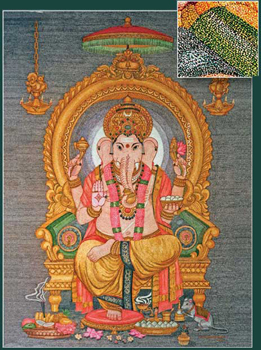
STONE-MELTING DEVOTION
Hanuman was so devoted to Ram, so filled with love for him, that he wanted nothing more than to continually remember Him. Not for one moment would he allow thoughts of his Lord to leave his mind, and so he continually lost himself in chanting Ram’s name. Hanuman was an accomplished musician, and often accompanied his chanting with the vina—a stringed instrument also played by Narada, the celestial sage who wanders among the worlds chanting Narayana’s name. Once in his wanderings Narada happened to overhear Hanuman’s chanting and was so attracted by the power and sweetness of his devotion that he set his own vina aside, and joined Hanuman in his chant. The intensity of Hanuman’s devotion and the loveliness of his song were so powerful that they melted even the hardness of granite; the rock on which Narada’s veena was resting softened, and the instrument sank gently into the stone. When Hanuman stopped chanting, the rock hardened and Narada’s vina was held fast. Narada begged Hanuman to begin chanting again; Hanuman of course was more than happy to comply: “Rama, Rama, Rama,” he chanted. Once again the rock melted with his devotion, and Narada was able to retrieve his vina.
A story from the Padma Purana submitted by Ganga/Marlene Roeder Gangamar108@yahoo.com

Mantra calligraphy: A portrait of Lord Ganesha created entirely of mantras penned in colored ink. A closeup of the artwork shows the tiny mantras used to “paint” this picture. Lord Hanuman sings to his Lord Rama.
Deity Mantras
The mantra is the name of the inner-plane being whom you are calling. If you say, “Aum Namah Sivaya,” are you ready to see what Siva will show you, once He comes and lifts the veils? Maybe a little preparation—cleaning a few things, straightening up the house, the subconscious basement—is in order first. If you say, “Aum Sharavanabhava,” is your mind really ready to become peaceful, or is it disturbed by fits of anger? But every soul is ready to say, “Aum,” and come to the feet of the Lord of Categories, who will set everything in order from the many yesterdays.
If you are in the temple worshiping Lord Murugan, the mantra Aum Sharavanabhava obviously has a total, overall effect. If you say “Aum, Aum, Aum” in front of Ganesha, Ganesha becomes conscious of your presence. The Deities are present in the temple. They may not be present in a person’s home or under a tree. The main effect the mantra would have there would be to focus the concentration and quiet the mind.
If someone is already meditating and is self-instructed, not under a guru, and working for an eventual initiation to receive a mantra upon which to do japa, then whatever japa is performed should neither be too much nor too intense. We suggest for the non-Hindu Aum, and for the unitiated Saivite Aum Sharavanabhava, 108 repetitions prior to meditation. This is totally on the safe side and will greatly enhance the meditation.
There is an idea that there is a special mantra for each person, and that a mantra should be secret. It has been my experience that gurus who are amassing wealth from unsuspecting Americans and Europeans will give all kinds of mantras. And they will be couched in a format that is sellable, like packaged merchandise. They will be made secret. But none of the traditional mantras that produce true realization and are lauded and acclaimed are secret. They are well known by every Hindu in the world. Each Hindu throughout the world knows whether he has purified himself or not, and prepared himself or not, sufficiently to pronounce them—though he may pronounce them at any time he wishes, and an impact and a beneficial effect will follow in his life. But the spiritual impact of pronouncing a mantra after earning an initiation (this does not mean paying for it, but earning it through study and practice, character building, improving, proving oneself to one’s guru), that effect, is life-altering. It cleans the karmas of many past lives, perfects the lives of the future, and lays the foundation for moksha at the end of this or a future life. Let this not be misunderstood.
Many people want initiation because they want to get away from something. They want something to cure their ills. Others don’t know what they want. They are disturbed, distraught with their prarabdha karmas, and they want relief. What they should be given is Saiva Siddhanta—a comprehensive path of accomplishment. They should not be given a high-powered mantra that will, when it opens the mind, cause more frustration and disturbance from what the seeker sees. But once given such initiation—having no tools, mentally, emotionally or physically, to conquer the past karmas that the experiential emotions are intensifying (which should have been conquered through karma yoga and bhakti yoga)—the seeker falls into despair. It is the conscientious guru’s responsibility to provide an ongoing, progressive training prior to initiation and to continue it afterwards. Those who make their living by selling mantras would be considered fraudulent by traditional Hindu standards.
The Esoterics of Japa
Knowing the meaning of the mantra is very helpful when the devotee is visualizing it at the same time. Then he also knows when he reaches the goal which the mantra is supposed to produce within him. Since most mantras are in Sanskrit, it is easy enough to find the meaning in the Sanskrit dictionary. We must remember that the first mantras were given in the language spoken by the people. Sanskrit mantras were given to people who spoke Sanskrit. Yet, mantras could be phrased in other ancient sacred languages as well. It is just that the Sanskrit language relates to the unfoldment of the inner being, which most other languages don’t do as much. However, even in the English language, or any language, rituals are performed that do invoke the spirit forces of the religion. It just so happens that in Hinduism, Sanskrit is the most accepted language of all, agreed upon by the Hindu hierarchy of all three worlds.
Japa is a sadhana, and all sadhana is repetitive. Japa is taking a few words as a mantra and repeating it over and over again for mind control and personal enlightenment. This would attract good beings on the astral plane and strengthen the protective aura of the individual doing japa. There is no reason to think that performing japa would affect the astral world in any way other than to bring forth goodness, compassion and admiration of the beings there toward the devotee performing this discipline.
Namah Sivaya Aum and Aum Sharavanabhava have been revealed for spiritual unfoldment. They are not for magical purposes. Nor is japa intended for healing or other aims in the physical realm. True, Japanese Buddhists chant Aum Namo Myoho Renge Kyo for success, jobs and wealth, but this is not japa in the Hindu understanding. This is more along the lines of affirmation. Japa is very close to raja yoga. Japa leads to spiritual renunciation; raja yoga to enlightenment, stimulating the chakras of the head. Japa is never used in the Hindu tradition to pray for material things. Hindus do pray for material blessings, health and abundance but not through the use of mantras, or japa. For these they turn to prayers, songs and ritual, which stimulate the chakras of willpower, reason and cognition, giving the worshiper physical, emotional and mental vigor to bring the worldly goods into his hands. Mantras for japa are usually short, but not always. The Gayatri Mantra, consisting of thirteen words, is an example of a rather long mantra. In summary, japa is religiously repeating just a few important, well-defined words, syllables or “seed sounds,” called bija, to awaken the higher nature.
GUIDELINES ON THE USE OF MANTRAS
- Chant the mantra with a sattvic, or pure, mind, which implies a peaceful intention and a calm frame of mind. Follow a sattvic lifestyle, including a vegetarian diet. Refrain from negative emotions, take time in solitude and make your life a form of service.
- Honor the Divine power connected to the mantra before starting your practice, whether through mental acknowledgment, some form of ritual, or through a representative form like a statue or picture.
- Seek further empowerment with the mantra from a guru, a holy site connected to its Deity, or through the forces of nature, like fire or water.
- Make sure to pronounce the mantra properly. For this you may need to learn the basic rules of pronouncing the Sanskrit alphabet.
- Initially chant the mantra out loud to gain a sense of its sound pattern. Then chant it softly on the breath to connect it to the prana. But most chanting will be mental, while you are silent outwardly.
- Chant the mantra in a regular manner at a certain time of day for a certain number of times.
- For counting mantras, it is best to use a mala, or rosary, of 108 beads.
Vamadeva Shastri

Where did mantras come from? Mystical shlokas came from the rishis of ancient times who held conversations with the great Mahadevas and devas of the inner worlds. Out of this developed certain rituals that could, when performed properly, create certain causes in the physical world.
Because every sound has a color and creates a form on the astral plane when pronounced, the mantra must be pronounced properly, slowly, thoughtfully, with feeling, mentally seeing the color, mentally hearing the sound. The ideal way to perform japa 108 times is by also listening to the nada-nadi shakti, the high “eee” sound one hears within the head when in a high state of consciousness. To perform japa quickly, as in a marathon, sometimes called “machine-gun japa,” brings little benefit. If you don’t have time to do japa, don’t do it at all. It should not be a meaningless ritual. It should be a very meaningful experience.
When we perform japa aloud, it is easier to concentrate the thought. The mantra is heard and therefore our mind does not wander. We must remember that letting the mind wander into irrelevant thoughts mitigates the benefits of the japa. Therefore, we must remain concentrated. We perform japa, which is a sadhana, for pragmatic benefits. There is no other reason. Therefore, we should keep our mind on what we are doing.
Visualize the proper colors that the mantra produces from one stage to the next. In Sharavanabhava Aum we visualize light blue fading into white and fading back into light blue, back and forth—“Sharavanabhava Aum, Sharavanabhava Aum, Sharavanabhava Aum.” Blue is the color of the akasha, ether, and Sharavanabhava takes you there. Once the japa is perfected aloud, it may be done silently, simply by moving the lips but not making a sound, and then later making the sound internally without moving the lips. The ultimate accomplishment in the performance of japa is the yoga of going to sleep while verbally and mentally pronouncing the mantra, which continues during the sleeping hours. Upon awakening, the same mantra is still being repeated, mentally and then verbally, without a break in continuity. This is quite an accomplishment, but it has been done.
Getting the Most from Japa
The repetition of a mantra, especially if given by a guru, is a journey to a distant place; consciousness is altered. And it must be performed at an auspicious time. Preparation must be made—bathing, cleaning oneself properly—then devotions are performed in a room prepared for this purpose. We are taking a journey; the room, the body and the exact time of starting are the conveyance.
If precaution is not taken, or the mantra is chanted at an inauspicious time in a place that is not sanctified, and the chanter’s body has not been cleansed, the mantra will work as it should, no problem here. But the person who is performing the incantations will be easily seen, due to the power of the mantra, by asuric entities, who will come and attach themselves to him and disturb him. In a clean and perfect place, under sanctified conditions, the incantation will attract devonic forces who will, in turn, help him on the path to his eventual enlightenment.
For the ultimate benefit in performing the japa sadhana, look on the Hindu Vedic calendar, panchanga, and choose the amrita yoga days. These are the most auspicious. Next are the siddha yoga days. On any given day, the most auspicious time is during gulika kala. These are the times when the forces of the universe—this means the entire universe, and most especially our galaxy—promote spiritual unfoldment. Of course, the daily experience of 108 repetitions should persist. Any intensification of this—1,008 times, for instance—would be best performed at a specially auspicious day and time. Other auspicious times of day are before sunrise and at sunset. The very best place and time to perform japa is in the temple after the puja, when all is quiet. This is the most ideal surrounding to repeat japa 108 times to gain maximum benefit. When performing japa, just breathe normally. Japa may be preceded by the pranayama practice that you have been taught by your guru.
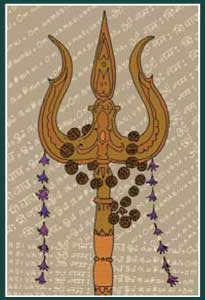
SEEING GOD EVERYWHERE
It is natural to forget about God, but there are many helpful ways that we can avoid distraction, that we can remember to keep seeing God Siva everywhere. One of the practical ways to bring God Siva into the midst of all this is to keep repeating His name. Do japa when you find yourself forgetting, when you just can’t see God at all, let alone everywhere. Repeat “Aum Namah Sivaya.” When life becomes difficult or strained, say to yourself, “Siva Siva” or “Aum Sivaya” or “Namah Sivaya.” Mentally put it all at His feet. See Him in everyone that you meet or confront, regardless of the circumstances. He is there as their life force, but you just need to quiet the mind to see. Smile when you feel unhappy with someone and say to yourself, “How nice to see you, Siva, in this form.” Animals, beggars, princes, politicians, friends and enemies, holy men, saints and sages are all Siva to the soul that loves God. He smiles and thinks to himself, “How nice to see you, Siva, in this, another of your many forms.” For Nathas, the repetition of the sacred Panchakshara Mantra, Namah Sivaya, is the key to the awakening of Sivaness within each and every devotee on the path to Lord Siva’s holy feet. This knowledge unfolds from within as these great mantras are incanted, such as “Aum Namah Sivaya,” which will finally awaken the experience of Siva’s perfect universe. Everything is in perfect harmony, law and order. Mantras are given by a guru, and this is important because his shakti gives the first impetus to proceed. It is not the same as when taken from a book, because the thrust is not there. It must come from a guru.
Satguru Sivaya Subramuniyaswami
Japa is a very good preparation for meditation. And you meditate on the mantra as you do the mantra. You can’t meditate on the mantra without repeating the mantra inwardly. When the mantra is linked with meditation, it should be pronounced slowly so that you can meditate on each syllable of the mantra that is being repeated. You must remember that japa is the repetition of a few words or a few syllables. That is the sadhana of japa. Everything else is something else.
My satguru, Siva Yogaswami, placed great emphasis on japa, repeating the name of Siva with concentration and feeling. This great Natha jnani explained, “May we not forget that mantra is life, that mantra is action, that mantra is love, and that the repetition of mantra, japa, bursts forth wisdom from within. Japa yoga is the first yoga to be performed toward the goal of jnana. In the temple perform japa. Under the sacred tree, perform japa. I performed japa all of this life as a silent sadhana, and it is automatic now.” Siva Yogaswami enjoined his devotees: “Wear rudraksha beads, repeat the Panchakshara, let your heart grow soft and melt. Chant the letters five, and in love you will discover Siva’s will. Chant so that impurities, anxieties and doubts are destroyed. All hail Namah Sivaya.”
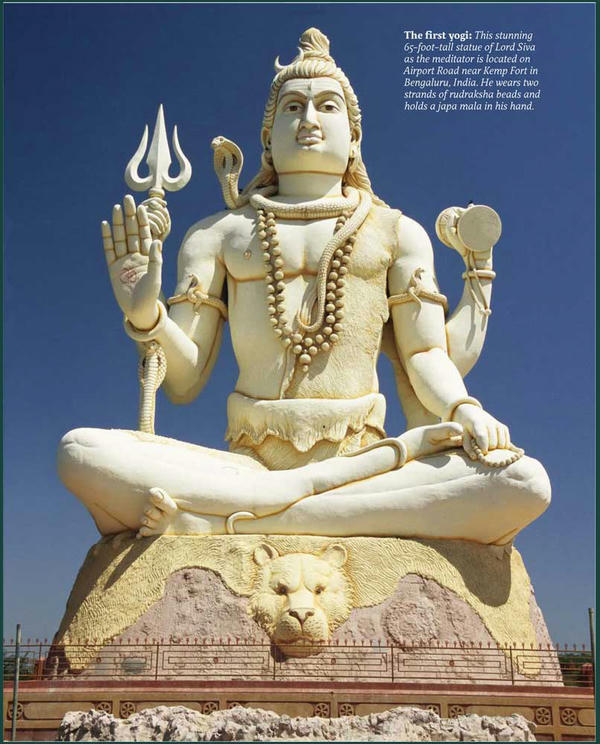
THE INNER SOUND CURRENT
Laya yoga, the “yoga of mergence,” involves meditation on the inner sound current, called nada, which arises when the mind becomes pure and clear. We can hear this vibratory sound if we close our ears and listen deeply with attentive awareness. Several types of nada exist. These are said to be like the sounds of a bell, a drum, a flute, the ocean or other sounds. Nada is the celestial music within us. We hear these sounds with our inner ear, the subtle counterpart of our gross organ of hearing. They reflect the sound of the cosmic intelligence inherent in space, which is the source of all knowledge.
Nada is the inner power behind the mantra. The outer mantra works to awaken the inner nada. Then the nada repeats the mantra, which is held in our inner sound current. The nada itself can assume the form of the mantra. This indicates that the mantra is resonating with our inner being.
To meditate upon the nada is not just to listen to or to repeat a sound. It is also to inquire into the origin of sound, to follow the sound current back to its origin. This is to inquire into the origin of our own consciousness, which itself is a manifestation of sound. It is to contact our inner Self in the spiritual heart from which the sound current arises.
All forms of spiritual music come under the Yoga of Sound if we follow their vibrations back to the Divine Word within us. This includes vocal and instrumental music in all their beauty and diversity. Music, in turn, may be allied with poetry, drama and dance. Poetry is a kind of verbal music. Drama is the enactment of poetry. Dance is its expression. The internal usage of music can energize the various chakras that reflect the music of our soul.
Vamadeva Shastri
Excerpts from Mantra Yoga and Primal Sound
By Vamadeva Shastri
The Universal Tradition of Sacred Sound
 LL OVER THE WORLD WE FIND TRADITIONS OF SPECIAL WORDS OF POWER, magical phrases or secret codes that can unlock the great mysteries of life otherwise unapproachable to the human mind. Such traditions occur in religion, occult sciences, mysticism, shamanism and almost every known spiritual path. Poetry, literature and philosophy worldwide similarly recognize the power of the word, sound or prime concept to influence and move us at a very deep level. While accessing the cosmic powers may not be as simple as repeating a phrase like “open sesame,” there are key sounds and words that can dramatically reveal new vistas of insight and energy within us.
LL OVER THE WORLD WE FIND TRADITIONS OF SPECIAL WORDS OF POWER, magical phrases or secret codes that can unlock the great mysteries of life otherwise unapproachable to the human mind. Such traditions occur in religion, occult sciences, mysticism, shamanism and almost every known spiritual path. Poetry, literature and philosophy worldwide similarly recognize the power of the word, sound or prime concept to influence and move us at a very deep level. While accessing the cosmic powers may not be as simple as repeating a phrase like “open sesame,” there are key sounds and words that can dramatically reveal new vistas of insight and energy within us.
While the yoga practitioners of India have developed sacred sound into an extensive science of mantra as discussed in detail in my book, it is important to note that the tradition of the transformative power of “the Word” is universal. What makes the yogic approach so important and compelling is that it looks at the power of sound and the Word in an experiential manner as part of a sacred approach to the whole of life and consciousness.
The Judeo-Christian tradition starts with God creating the universe through the Word: “Let there be light;” and there was light. The New Testament ponders, “In the beginning was the Word.” The monastic history of Christianity includes prayer, chant and formalized words of meditation. Church services frequently include responsive chants of “Amen.” The Jewish Kabala has mystic syllables and explains the Hebrew alphabet in a similar way relative to cosmology as the yoga tradition does the Sanskrit alphabet. Sufism relies on the power of oft-repeated prayers and divine names to bring life into harmony with the Spirit.
Taoism has an important tradition of healing sounds for body and mind that is used in Taoist yoga and traditional Chinese medicine. Buddhism has its own rich tradition of mantras, particularly in the Buddhist tantras and in Tibetan Buddhism. These are largely Sanskrit mantras and include many of the same mantras as in the Hindu yoga tradition. Shamanic healing from all over the world invokes healing powers through chant and prayer, with diseases expelled in its rituals through the use of an emphatic phrase or mantra. We find traditions of sacred sound in all ancient cultures, from Egypt and Babylonia to India, China and the Americas, as the ancient world lived more closely to the magic of the Divine Word.
Many traditions teach that if you know the name of something, you can gain mastery over it. This is an expression of the occult, mystical sense of being able to create the vibration or resonance of the object to fully identify with it. It is not the outer name, such as we find in a dictionary, which grants this power but the inner name that is a mantric vibration. There is a sound code or vibratory pattern behind the universe itself, embedded in the fabric of existence that holds the intelligence, information and energy forms through which all processes of life operate. Connecting to this universal vibration is the basis for the yogic pursuit of mantra.
Yet, apart from the mysticism of mantra, there is a practical side to mantra that is also gaining wide recognition today. Mantra as a term has entered into languages worldwide. Mantra is now commonly used to indicate a key word or phrase employed by various groups or individuals to summarize their views or relate their prime focus. This practical idea of mantra fits in well with the computer age, in which complex information is passed on in concentrated data bits that connect us to wider fields of knowledge and energy. It is what we could call “the mantric approach of information technology.” A mantra-like condensation of knowledge has become essential to modern communication and higher education. It is the ancient basis of the “Powerpoint” presentation, among many other such concentrated teaching devices.
The power of the Word is easily seen in our everyday lives, as the words help create the environment within which we live, for good or ill. Road rage is frequently accompanied by expletives, and the pent-up energy behind them frequently breaks out in fights, tension and traffic accidents. Political rallies and sports competitions use key phrases and chants to create a mass energy to stimulate action and bring about victory; to get the crowd involved, as it were, which can have positive or negative effects on a large scale.
The mass media world relies on key words, slogans and advertising phrases. Such short statements become the news stories in brief and can impact public opinion and sentiment globally, affecting us at subconscious and conscious levels. These concentrated sound messages are all mantras, or power words, of sorts. Through the science of mantra yoga, we can navigate our way through the influences of the dominant words reverberating around us to a higher truth, discerning the sounds that weigh down our consciousness from those that elevate it.
The reality behind these sacred or mundane uses of words of power is that words carry energy, creating and embodying the inner essence and forms of manifestations in the world. Each outer object has its own characteristic sound vibration that sustains it. Our own bodies, minds and hearts have their own characteristic sound patterns, which in turn are affected by the spectrum of sounds around us.
JAPA BEADS
Malas are important tools of both worship and healing. They relate to different Deities and have their specific powers that can be used to hold the energies of mantras in different ways. When we use a mala with our mantra recitation, the power of the mantra enters into the beads of the mala, which become energized at a subtle level. The more often we use them, the greater their power becomes. The mala gathers and magnifies the power of the mantra, forming a sphere of energy and protection around us.
Rudraksha is the most commonly used bead for malas. It is the seed of a special tropical tree (Eleocarpus ganitrus). It comes in different forms, but overall it is heating and sacred to Lord Siva, increasing tejas and agni. It also helps arouse the kundalini. There are several types of rudrakshas, with the smaller beads generally regarded as more powerful. However, the large, five-faced beads are also very powerful. They relate to the five faces of Lord Siva. One-faced beads relate to the Supreme Siva and pure unity. Two face beads are Siva-Shakti. Rudrakshas can be found with faces up to fourteen, which all have their special powers. Rudraksha, however, can be too hot for some people. One may need to combine it with sandalwood or crystal to make it suitable. Sandalwood malas are cooling and soothing to the mind and heart. They are sacred to Vishnu.
Tulsi, or holy basil, malas are stimulating and help open the mind and heart and are often used relative to Vishnu, Krishna or Dhanvantari. They are made of the wood from the bush. Crystal malas are cooling and clearing. They are often sacred to the Goddess, but can relate to Siva as well. Combined crystal and Rudraksha malas are Siva-Shakti. Coral malas are warming and strengthening. They are often used to promote the Siva energy as well. Astrologically, they relate to the planet Mars.
Malas can also be made of gems that reflect planetary energies. Garnet malas have a solar energy, pearl malas a lunar energy. Coral malas relate to Mars, green gemstones (like peridot) to Mercury, citrine to Jupiter, clear crystal to Venus, amethyst to Saturn, hessonite garnet to Rahu, and cat’s eye to Ketu. Malas can be stranded in gold, silver, copper or other types of threads. Gold is probably the most powerful.
Wearing a mala, one should note, is not a matter for public display or a fashion statement. While one can wear a protective mala at all times, one usually keeps special sadhana malas away from public contact, viewing or touch. Remember, the mala is a sacred implement that itself needs to be honored.
Vamadeva Shastri
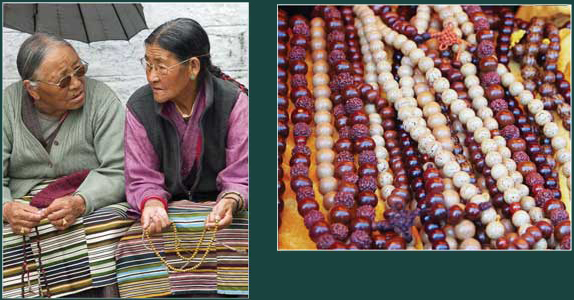
A special charm: Two women in Tibet chat while holding their prayer beads; a beautiful selection of japa malas is laid out for sale in an Indian shop
Yoga as Sound
Mantra yoga provides us a means to understand sacred sound from the perspective of a tradition that has taken it beyond mysticism into an organized and codified spiritual science. Mantra yoga includes a study of the qualities inherent in sound itself, through which words and meanings are either properly shaped or deformed. It shows how sounds impact the nervous system, mind and heart, and how we can modify them to improve our lives. Regardless of which background or tradition you may personally follow, the insights provided in mantra yoga can be of enormous value to enable you to manifest your destiny creatively, effectively and completely through understanding the power of the Word.
Mantra is a tool for connecting us with the spiritual wisdom and the energy of consciousness hidden in the universe as a whole. Mantra is a doorway to an awareness that exists beyond all limited bits of information or technical knowledge. Mantra summarizes an inner view of reality as a play of consciousness that can instantly comprehend the whole, grasping the totality in a single point focus of direct perception and immediate experience. The universe itself is ultimately an expression of a single mantra or vibratory sound energy.
Mantra in the yogic sense relates to the prime energies, ideas, principles or archetypes of the cosmic intelligence that directs the forces of nature and the movements of our own minds and hearts. Mantra is part of a universal language rooted in sound, image, number and symbol, reflecting a “cosmic thinking” beyond the preconceptions and biases of human thought. Mantra functions according to the inner mathematics of cosmic law. It serves to link our individual intelligence with the greater intelligence that pervades all space, extending our awareness into the Infinite and Eternal. To chant a mantra at a deeper yogic level is to think with the entire universe and to access the wisdom and experience of all beings.
There are mantric sounds that can awaken the higher potentials of the brain and change the flow of energy in the nervous system. Each one of us has a unique sound pattern that sustains all that we do and allows our energies to move and grow or stagnate and decline. Unless we learn to harmonize our inner sound vibrations, our lives will likely remain in disharmony and suffering. Mantra is the most important tool for attuning our bodies and minds to their proper resonance, which is not with the outer world, but with the divine presence that constitutes our own deepest Self.
Focusing on a specific mantra—particularly holding to a bija [seed] mantra—is one of the main methods of dharana, or yogic concentration. Continuously directing the mantra to a particular location like the tip of the nose or to a particular chakra turns it into a dharana practice. Very helpful in this regard is “mantra drishti,” or the gaze of the mantra, in which one concentrates one’s gaze along with the mantra, particularly on sites in the body like the heart, the third eye, the navel or the base of the spine.
As asana [posture] controls the body and pranayama controls the breath, so mantra controls the mind, not artificially but through a natural development of energy and attention. Mantra maintains the strength and integrity of our mental field, so that the mind no longer wanders off or loses its composure. Mantra sustains the proper circulation of energies in the sphere of the mind, so that we are no longer vulnerable to external conditioning which, after all, is based largely on reactive patterns of words and names.
Just as asanas place the body in a calm and relaxed state, so mantras puts the mind into a steady and relaxed state for meditation. For example, repeating the mantra Aum has the same calming and uplifting affect upon the mind and heart that the lotus pose does for the body.
THE YOGA OF SOUND
Shabda yoga, the yoga of sound, formulates the Supreme Reality as Shabda Brahman, or transcendent sound. This tradition goes back to the Vedas, where the entire universe is said to rest in a single, imperishable sound. Aspects of this teaching continue in all the different branches of yoga. The main insight behind the Yoga of Sound is that reality consists of vibration, which in essence is sound. Even the formless, silent Absolute has its own vibration, or shabda, but remains contained in itself, a kind of breathing without the breath, as it were. This sound of consciousness is called the “non-elemental sound,” as distinguished from the elemental sound that arises through the ether element. By going back to the reality of Primal Sound, we can return to the very heart of creation and reach the Absolute, beyond time and space, from which all creation arises. We can reach the state of silence or pure stillness that is total communication and complete unity.
Vamadeva Shastri

Japa and the breath: Counting repetitions, a devotee pushes successive beads over his third finger with his thumb; during his morning sadhana, a man performs a basic pranayama, alternating inbreaths and outbreaths through each nostril
A Form of Meditation
Mantra is not only an important preparation for meditation, “mantra meditation” is one of the main types of meditation, with many variations. After all, our main mental fixation is with words. Mantra allows us to turn this negative attachment into a positive inspiration, as we replace our ordinary words and phrases with mantras.
Mantra practice gradually calms and integrates the mind. The mind becomes silent, concentrated and reflective, allowing our awareness to vibrate with the mantra. This naturally leads to deeper meditation, in which the mantra may fall away. Formless meditation is hard to achieve directly but becomes easily accessible once one builds the power of mantra in the mind. When we repeat a mantra, or do various forms of chanting, a more refined vibration develops and begins to assume the background pattern of our mind, down to a subconscious level. If we continually return to the mantra each time our mind becomes agitated, then the mantra’s power to calm the mind will increase.
It should be beneath our dignity as a divine soul to allow our minds to dwell on negative thoughts and emotions, fears, desires, jealousy and hatred, or to be controlled and distracted by external influences. With the mantra, we have a tool for redirecting the energy of the mind within so that we can reclaim our inner composure. Mantra can help us break up deep-seated mental and emotional patterns, conditioning and traumas even from childhood.
Traditional yoga practice consists of two primary stages: 1) to develop sattva guna, or purity of body and mind; 2) to still the mind and go beyond it to the higher Self, or Purusha.
The first stage of yoga requires promoting sattva guna to create the proper balance in the mind, removing toxins and doshas from the body, and neutralizing the residual energies of rajas and tamas, or agitation and inertia, from the subconscious. The second stage consists of going beyond the mind-body complex and all of its conditioning, even that of sattva guna, to pure awareness.
Generally we cannot succeed at the second step if we have not accomplished the first, which is its prerequisite. Many problems in yoga practice arise from attempting the second step when the first has not been accomplished (in some cases it may not have even been attempted!). People may try to meditate in stillness, or enter into the oneness, while their minds remain outwardly oriented and caught in the disturbances of the body and senses. The proper practice of mantra helps neutralize such difficulties, developing sattva, or harmony, in the deeper mental field.
If our minds are noisy, disturbed, hypersensitive, reactive, opinionated, critical, or just constantly busy, we cannot silence them. If we are addicted to sensory sources of stimulation and entertainment, we are not even in control of our mind and so cannot focus it in any consistent manner for meditation. First we must set in motion forces to take the mind from its disturbed (rajasic) or dull (tamasic) state to its natural, clear quality (sattva). Mantra is the main practice for changing the nature of the mind from tamas and rajas to sattva. At the same time, it provides us the focus and energy for going beyond the mind.
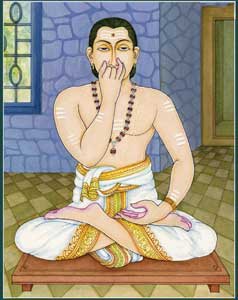
MANTRA & PRANAYAMA
Pranayama [controlled breathing] and mantra naturally go together and work best in combination. Using a mantra along with pranayama unites the mind and prana, drawing our attention and awareness into the breathing process. It can turn pranayama into meditation, as well as bring energy, vitality and wakefulness into the repetition of the mantra. Uniting prana (our power of action) with the mind (our power of knowledge) integrates us back into the source of our being. Prana gives shakti to the mantra and makes it alive and vibrating within our entire body. The sound of the breath is our most natural and constant outer mantra, we could say. The sound of our heartbeat, which is connected to the sound of the breath, is our most natural internal mantra. An important goal of mantra practice is to get one’s mantra to resonate with the breath, so that it is naturally repeated, strengthened and deepened along with every breath that we take—and then to get it to resonate with every heartbeat, so that our heartbeat is the beat of the mantra.
Vamadeva Shastri
Use by Yogis
Mantra is probably the main practice that characterizes yoga as a whole and its many different branches. All yogic paths use mantras and have special mantras of their own. Special mantras and chants pervade the primary yogas of knowledge (jnana), devotion (bhakti) and service (karma) in which asana does not have an important role. Yet even in hatha yoga, where asana can be very important, mantra remains significant and is the main method employed to prepare the mind for deeper yoga practices.
The Yoga Sutras and its tradition of raja yoga emphasizes the role of the Pranava, which literally refers to “primal sound,” and specifically to the mantra Aum, as the main means of connecting with the Divine or Cosmic Lord, Ishvara, the primordial guru of gurus in the yoga tradition. Just like the Upanishads, the Yoga Sutras stress the importance of chanting and meditating upon Aum, which is the essence of all mantras. This means that mantra is the guiding power of yoga, not just one of its many practices!
Bhakti yoga, the yoga of devotion, centers on chanting, singing and the internal repetition of divine names, like Namah Sivaya or the Hare Krishna mantra, as the best means of developing deep devotion and divine love. In fact, the word of the heart is always mantra!
Jnana yoga, the yoga of knowledge, focuses on prime Atmic, or Self-revealing, mantras like So’ham, “He am I,” or the great sayings (mahavakyas) of Vedantic philosophy. Aum is also important as the sound of the Self. Such mantras are the foundation for the meditation and Self-inquiry practices that characterize jnana yoga practice.
Karma yoga involves an extensive performance of rituals, like pujas and yajnas, all of which have their accompanying mantras to empower and sanctify them. It includes various forms of service (seva) to others, which are best performed while repeating a mantra. Unless the mind is engaged inwardly in mantra, one may not be effectively practicing karma yoga even when performing service.
Hatha yoga and tantric yoga use pranic mantras, like Hum, to arouse the kundalini and open the chakras. The fifty main Sanskrit letters form the petals of the chakras and serve to energize them. The kundalini shakti, or inner power of yoga, is said to be composed of the letters or sounds of the Sanskrit alphabet and is primarily a higher mantric force. Kundalini is an electrical energy of speech at a deeper level of consciousness.
The practice of yoga usually begins with the chanting of mantras—which may be mantras to the guru, to the aspect of the Divine one worships, or to the higher self—in order to create the proper atmosphere for teaching, or mantras to sanctify the ground on which one sits. Mantra grants sanctity and concentration to yoga, which otherwise easily descends into another form of physical exercise or a seeking of personal empowerment.
Reproduced with permission from Mantra Yoga and the Primal Sound, by Vamadeva Shastri (Dr. David Frawley). Lotus Press, a division of Lotus Brands, Inc., PO Box 325, Twin Lakes, WI 53181, USA.
www.lotuspress.com ©2010 all rights reserved